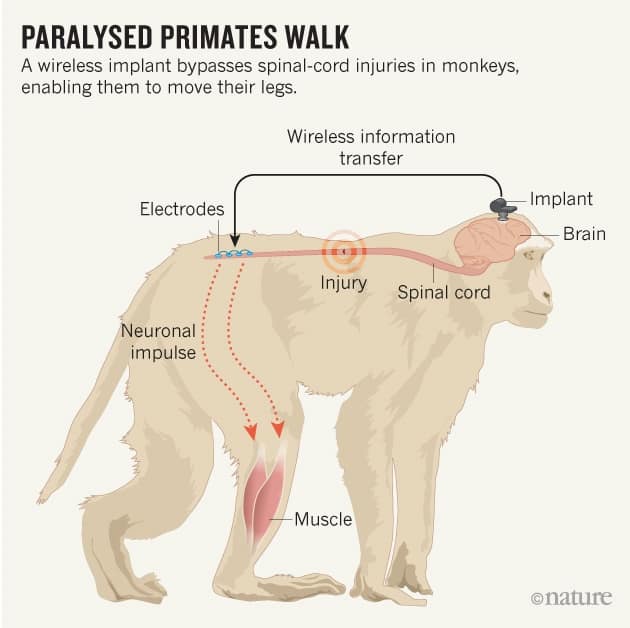
The implant, developed after a decade of research on rats, works by bypassing the injured portion the spinal column, sending signals directly from the brain to the intact nerves below the injury.
The researchers, led by EPFL neuroscientist Gregoire Courtine, call the implant the "brain-spine interface". It consists of several components, and takes advantage of the fact that even when spinal-cord injury causes paralysis, the motor sections of the brain remain intact and still produce the signals which is an uninjured vertebrate would order muscles to flex and relax; the nerves and muscles in the paralysed limb are also generally intact but merely are unable to communicate with the brain because of the spinal injury.
"To implement the brain-spine interface, we developed an implantable, wireless system that operates in real time and enabled a primate to behave freely, without the constraints of tethered electronics," Courtine explained.
The interface has two implants, one which attaches to the region of the motor cortex responsible for producing signals that control the leg; the other, a network of electrodes attached directly to nerve fibres is implanted on the surface of the spinal cord in the lumbar region, beyond the lesion which caused the monkey’s paralysis. The brain implant picks up the electrical signals produced by the cortex's nerve cells and transmits them to an external computer, which decodes the electrical spikes and send signals, again wirelessly, to the lumbar implant ordering the previously-inactive muscles to contract. The signals are only of the order of a few volts.
"We understood how to extract brain signals that encode flexion and extension of the leg with a mathematical algorithm," Courtine said. "We then linked the decoded signals to the stimulation of specific hotspots in the spinal cord that induced the walking movement."

The experimental subject, a Rhesus monkey, was suffering from type of spinal lesion that would normally self-correct after a few months, but the team believes that the implant would also work with more severe injuries (although this might also require the use of pharmaceuticals). No physiotherapy or training was required to help the monkey to walk; it started walking as soon as the implant was activated, according to Erwan Bezard, a neuroscientist from Bordeaux University who oversaw the primate experiment.
"The link between the decoding of the brain and stimulation of the spinal-cord – to make the communication exist – is completely new," said neurosurgeon Jocelyne Bloch of Lausanne University Hospital, who carried out the implantation operation. “For the first time, I can imagine a completely paralysed patient being able to move their legs through this brain-spine interface."
However, Courtine urged caution. "There are many challenges ahead and it may take several years before all the components of this intervention can be tested in people," he said. Courtine and the team explain their research, which also involved collaboration with Brown University; the Fraunhofer ICT-IMM Institute in Mainz, which concentrates on chemistry, energy technology, and analysis systems and sensors; and medical electronics company Medtronic, in a letter to Nature.




April 1886: the Brunkebergs tunnel
First ever example of a ground source heat pump?